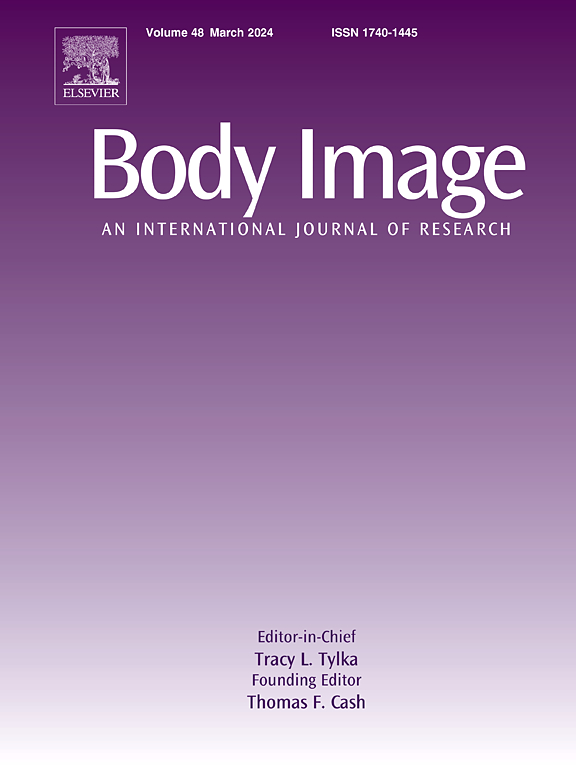青少年和成人外表相关社交媒体意识量表意大利版(ASMCS-I
IF 5.4
1区 心理学
Q1 PSYCHIATRY
引用次数: 0
摘要
与外表相关的社交媒体意识(ASMC)被定义为个人的思想和行为反映他们对社交媒体观众是否有吸引力的持续意识的程度。在这篇3项研究的论文中,我们报告了意大利对成年男性和女性的ASMC量表(ASMCS-I)的验证。在研究1中,通过访谈建立内容效度(N = 110;50 %女性;Mage=30.22)。研究2涉及144名参与者(66.00 %女性,Mage=36.51),探索性因素分析支持与原始版本量表一致的单因素解决方案。在研究3中,我们将ASMCS-I应用于另一个样本(N = 1008;66.90 %女性,Mage=33.29)进行验证性因素分析(CFA)和效度分析。CFA支持单因素模型,拟合指标较好。ASMCS-I得分具有较强的内部一致性、收敛性和递增性效度。ASMCS-I与身体监视、身体羞耻、自我物化、公共情境自我意识和外表比较存在趋同效度。ASMCS-I对身体监测量表(自变量)的增量效度在抑郁和饮食失调症状(因变量)中得到证实。最后,ASMCS-I在性别上是完全不变的,在年龄上是部分不变的,这表明它可以使用相同的量表来测量男性和女性以及不同年龄的社交媒体用户。这些发现进一步验证了ASMCS-I是一种可靠的工具,可以准确量化社交媒体环境下的身体形象自我意识。它提供了一种测量工具,对于推进数字环境对身体形象评估的心理社会影响的研究至关重要。本文章由计算机程序翻译,如有差异,请以英文原文为准。
The appearance-related social media consciousness scale-Italian version (ASMCS-I) in young adults and adults
Appearance-related social media consciousness (ASMC) is defined as the extent to which individuals’ thoughts and behaviors reflect ongoing awareness of whether they might look attractive to a social media audience. In this 3-study paper, we report the Italian validation of the ASMC Scale (ASMCS-I) for adult men and women. In Study 1, content validity was established through interviews (N = 110; 50 % women; Mage=30.22). Study 2 involved 144 participants (66.00 % women, Mage=36.51), with exploratory factor analysis supporting a single-factor solution consistent with the original version of the scale. In Study 3, we administered the ASMCS-I to an additional sample (N = 1008; 66.90 % women, Mage=33.29) to conduct confirmatory factor analyses (CFA) and validity analyses. The CFA supported the single-factor model with good fit indices. ASMCS-I scores demonstrated strong internal consistency, convergent and incremental validity. Convergent validity was found with correlations between the ASMCS-I and body surveillance, body shame, self-objectification, public situational self-awareness, and physical appearance comparison. Incremental validity of the ASMCS-I against body surveillance subscale (independent variables) was demonstrated with depressive and disordered eating symptoms (dependent variables). Finally, ASMCS-I is full invariant across gender and partially across age, indicating that it can be measured using the same scale for both men and women and social media users across different ages. These findings further validate the ASMCS-I as a robust instrument that accurately quantifies body image self-awareness in social media environments. It provides a measurement tool that is essential for advancing research on the psychosocial impact of digital environments on body image assessment.
求助全文
通过发布文献求助,成功后即可免费获取论文全文。
去求助
来源期刊

Body Image
Multiple-
CiteScore
8.70
自引率
28.80%
发文量
174
期刊介绍:
Body Image is an international, peer-reviewed journal that publishes high-quality, scientific articles on body image and human physical appearance. Body Image is a multi-faceted concept that refers to persons perceptions and attitudes about their own body, particularly but not exclusively its appearance. The journal invites contributions from a broad range of disciplines-psychological science, other social and behavioral sciences, and medical and health sciences. The journal publishes original research articles, brief research reports, theoretical and review papers, and science-based practitioner reports of interest. Dissertation abstracts are also published online, and the journal gives an annual award for the best doctoral dissertation in this field.
 求助内容:
求助内容: 应助结果提醒方式:
应助结果提醒方式:


